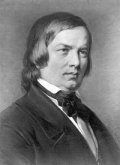
Robert Schumann
Robert Schumann came from a family with a history of mental illness, and Robert inherited the worst of it. He suffered all his life from what was then simply called madness, but is known today as manic-depression or bipolar illness.
Schumann was also an alcoholic and at some point in his rather promiscuous life, contracted syphilis, both of which also affect the brain. This combination would lead to a suicide attempt in 1854, a voluntary incarcertion in a mental asylum, and finally his death in 1856.
For us, however, what is more interesting than his death, is how the illness affected him during his life and shaped his compositions.
Manic depression is characterised by the extremes of mood swings, far in excess of those experienced by well individuals. At their depth, sufferers go through long periods of clinical major depression. They feel worthless, fatigued, guilty, hopeless. They sleep poorly, lose weight, and not infrequently suicide.
At their manic peaks, life goes at a thousand miles per hour, their bodies have trouble keeping up with their minds, they have grandiose thoughts, their actions are irrational. At its most severe, they can hallucinate and get other delusions.
Robert Schumann suffered many such cycles throughout his life. In fact, many artists have probably had manic episodes at least in a mild form, as a stimulus for their creativity. Handel wrote
The Messiah in a 24 day fit of mania.
For Schumann, the lows were very low, the highs were disturbingly chaotic. In the absence of modern medications, he tried to cope by drinking heavily. In addition he was a notorious womaniser and the syphilis that he contracted further affected his mind. The mercury that was used as a syphilis treatment is a neurotoxin, and probably caused the paralysis of his hand that prevented him becoming a pianist.
Schumann was a celebrated music critic and commentator. He was one of the first to champion the music of Chopin. And he wrote under two personalities, each with its own pseudonym; the measured, contemplative Eusebius, and the fiery, volatile Florestan.
When he was at a peak he composed feverishly. He would get a particular style in mind, and write piece after peice in that style. Most of his great songs were written in a single year 1840, and then never again. His four great symphonies were written near the end of his life. And the piano music on this CD all stems from just 2 years before his marriage.
The most significant person in Schumann's life was Clara Weick, the young daughter of his piano teacher. Father Weick objected to their marriage, but the couple bypassed his protests and married in 1840.
Theirs was a marriage in today's modern style. Both had careers, he as a composer, conductor and critic, and she as a concert pianist who performed throughout Europe. By all accounts, they had a very happy and fruitful relationship. Schumann wrote music for her to perform, and she suggested music for him to write. His orchestral music, including the symphonies were written at her suggestion.

Vladimir Horowitz
Schumann invented the short, romantic piano work, a style that Chopin was later to adopt. This music was all written between 1838 and 1840, the time of Schumann's courtship of Clara. This was a happy time for Schumann, and the music is delicate, lively and good-natured.
The
Kinderszenen, or Scenes from Childhood are a set of thirteen reminiscences of childhood, written during a temporary separation from Clara. As piano miniatures, they are wistful, charming and yet substantial. They include the very famous
Tršumerei or Reverie. They are works about children, rather than music written for children, and require a high degree of polish to perform them.
The
Kreisleriana are a set of eight pieces based on E.T.A Hoffman's character Kreisler, the mad concertmaster. This set represents Schumann's pinnacle of the genre - short, witty, devilishly clever, alternating with periods of absolute calm. Perhaps Schumann identified with his subject.
The three other pieces, the fiendish
Tocatta, the sublime
Arabesque and the charming
Blumestuck are also well-known and much-loved, rounding out this set of Schumann piano works.
This is an extremely famous recording by Vladimir Horowitz who brings out the tenderness and madness of his subject, Schumann being one of his favourite composers. In here we can hear Schumann remembering his happy childhood, yearning for love, and aching for a peace away from the torment of his mind.
Please support Good-Music-Guide.com
by purchasing this CD using this link.

Track Listing
Robert Schumann
Kinderszenen (Scenes from Childhood)
Kreisleriana
Arabesque
Tocatta
Vladimir Horowitz, piano
- Toccata Op. 7
Scenes From Childhood, Op. 15
- I. From Foreign Lands And Peoples
- II. A Curious Story
- III. Blind Man's Buff
- IV. Pleading Child
- V. Happiness
- VI. An Important Event
- VII. Dreaming
- VIII. At The Fireside
- IX. Knight Of The Hobbyhorse
- X. Almost Too Serious
- XI. Frightening
- XII. Child Falling Asleep
- XIII. The Poet Speaks
Kreisleriana, Op. 16
- I. Ausserst bewegt
- II. Sehr inning und nicht zu rasch
- III. Sehr aufgeregt
- IV. Sehr langsam
- V. Sehr lebhaft
- VI. Sehr langsam
- VII. Sehr rasch
- VIII. Schnell und spielend
- Arabesque, Op. 18
- Blumenstuck, Op. 19